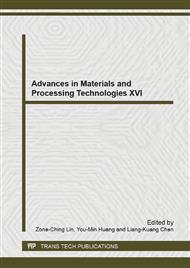[1]
T. Altan, G. Ngaile, G.S. Shen, Cold and Hot Forging, ASM International, (2004).
Google Scholar
[2]
S. Stupkiewicz, M. Zenon, Phenomenological model of real contact area evolution with account for bulk plastic deformation in metal forming, International Journal of Plasticity (2003) 323–344.
DOI: 10.1016/s0749-6419(01)00037-7
Google Scholar
[3]
N. Bay, A. Azushima, P. Groche, I. Ishibashi, M. Merklein, M. Morishita et al., Environmentally benign tribo-systems for metal forming, Annals of CIRP 59 (2010) 760–780.
DOI: 10.1016/j.cirp.2010.05.007
Google Scholar
[4]
Z.M. Hu, T.A. Dean, A study of surface topography, friction and lubricants in metalforming, International Journal of Machine Tools and Manufacture 40 (2000) 1637–1649.
DOI: 10.1016/s0890-6955(00)00014-6
Google Scholar
[5]
C. Caminaga, R.L. da Silva Issii, S.T. Button, Alternative lubrication and lubricants for the cold extrusion of steel parts, Journal of Materials Processing Technology 179 (2006) 87–91.
DOI: 10.1016/j.jmatprotec.2006.03.073
Google Scholar
[6]
P.T. Olesen, T. Steenberg, E. Christensen, N.J. Bjerrum, Electrolytic deposition of amorphous and crystalline zinc–calcium phosphates, Journal of Materials Science 33 (1998) 3059-3063.
DOI: 10.1023/a:1004379319348
Google Scholar
[7]
M. Arentoft, N. Bay, P.T. Tang, J.D. Jensen, A new lubricant carrier for metal forming, Annals of CIRP 58 (2009) 243–246.
DOI: 10.1016/j.cirp.2009.03.062
Google Scholar
[8]
M. Arentoft, N. Bay, P.T. Tang, J.D. Jensen, N.A. Paldan, I. Mizushima et al., Deposited Micro Porous Layer as Lubricant Carrier in Metal Forming, Proceedings of International Conference on Technology of Plasticity 9 (2008) 211–216.
Google Scholar
[9]
E. Ceron, N. Bay, M. Arentoft, P.T. Tang, Testing a New Microporous Lubricant Carrier for Cold Forging Steel Research International, Special Edition (2011) 240–244.
Google Scholar
[10]
D. Hemyari, Methode zur Ermittlung von Konstruktivmodellen für Reibvorgänge in der Massivumformung bei erhöhten Temperaturen, Shaker Verlag, Aachen, 1999. In German.
Google Scholar
[11]
H. Yoshida, S. Ito, S. Isogawa, K. Dohda, Development of New Tribo-meter for Forging, Proceedings of International Conference on Technology of Plasticity 9 (2008) 217–222.
Google Scholar
[12]
P. Groche, C. Müller, J. Stahlmann, S. Zang, Mechanical Conditions in Bulk Metal Forming Tribometers - Part One, Tribology International 62 (2013) 223–231.
DOI: 10.1016/j.triboint.2012.12.008
Google Scholar
[13]
N. Bay, The state of the art in cold forging lubrication, Journal of Materials Processing Technology 46 (1994) 19–40.
DOI: 10.1016/0924-0136(94)90100-7
Google Scholar
[14]
N. Bay, O. Wibom, J. Nielsen, A New Friction and Lubrication Test for Cold Forging, Annals of CIRP 44/1 (1995) 217–221.
DOI: 10.1016/s0007-8506(07)62311-7
Google Scholar
[15]
C. Müller, D. Reuter, P. Groche, Untersuchung des Witterungseinflusses auf tribologische Systeme der Kaltmassivumformung, Schmiede Journal September 2012 (2012) 42–45. In German.
Google Scholar
[16]
P. Groche, C. Müller, D. Reuter, Wasser senkt Reibung, Umformtechnik 4/2012 (2012) 35–36. In German.
Google Scholar
[17]
P. Groche, J. Stahlmann, C. Müller, Mechanical Conditions in Bulk Metal Forming Tribometers - Part Two, Tribology International. Accepted paper. http: /dx. doi. org/10. 1016/j. triboint. 2012. 11. 028.
DOI: 10.1016/j.triboint.2012.11.028
Google Scholar
[18]
P. Groche, J. Stahlmann, J. Hartel, M. Köhler, Hydrodynamic Effects of Macroscopic Deterministic Surface Structures in Cold Forging Processes, Tribology International 42 (2009) 1173-1179.
DOI: 10.1016/j.triboint.2009.03.019
Google Scholar
[19]
J. Stahlmann, K. Damavandi, P. Groche, Erste Erfahrungen bei dem Einsatz einer Servomotorpresse in der Kaltmassivumformung, Tagungsband Jahrestreffen der Kaltmassivumformer (2009). In German.
Google Scholar


